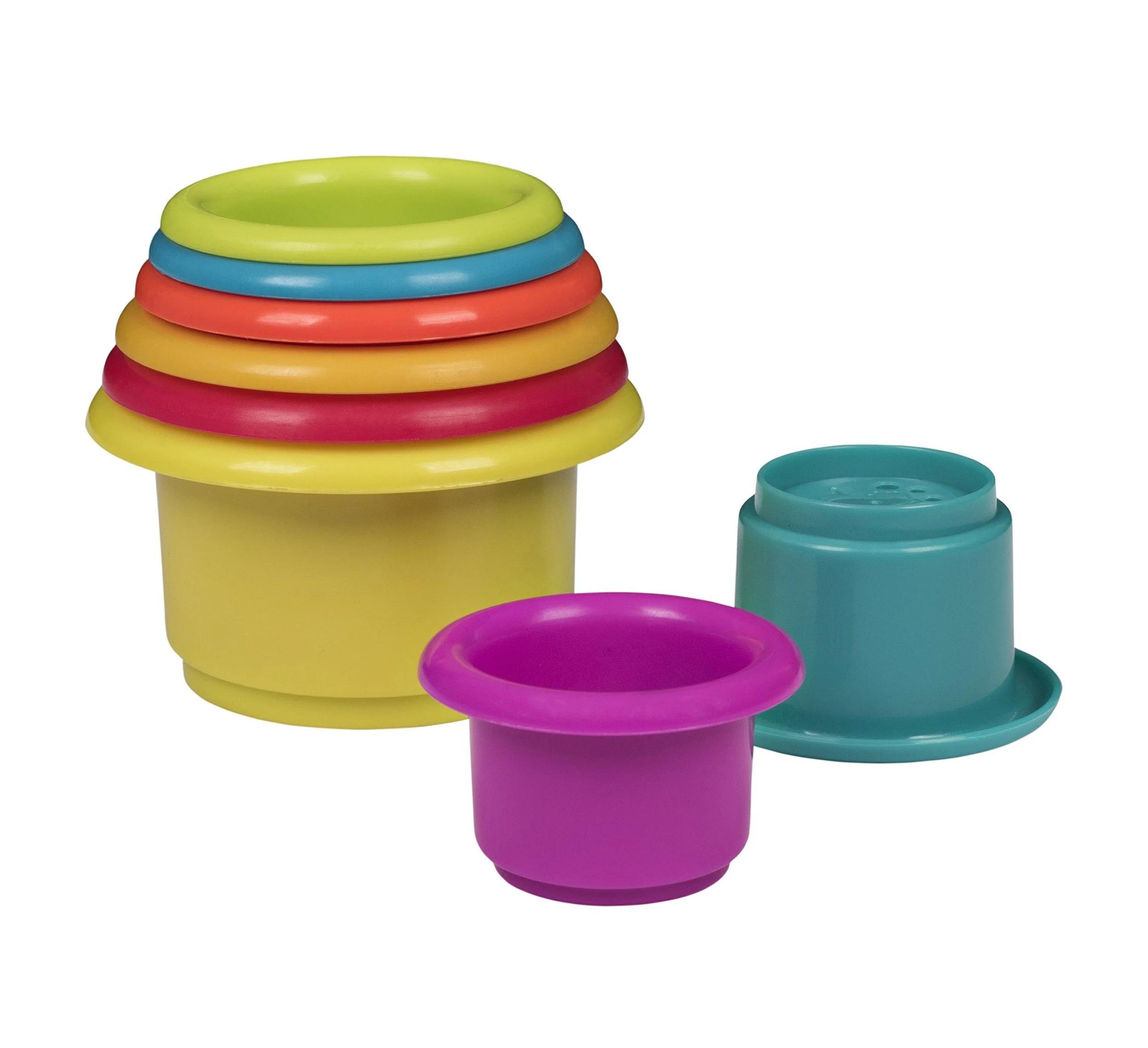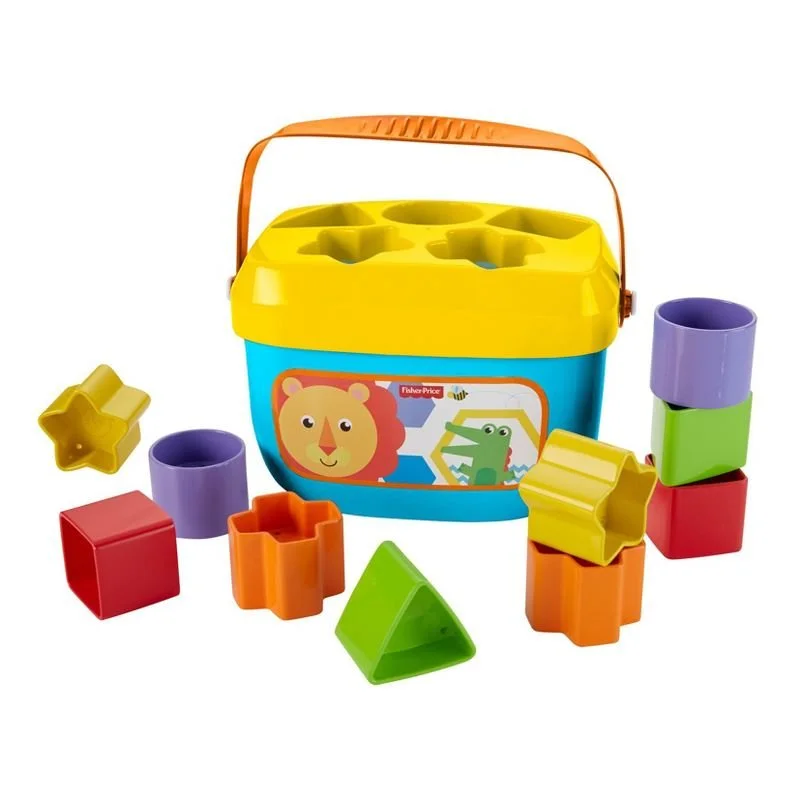Speaking of Play: 9-12 Months
During the first few months of life, your child is observing his world. Now that he is older, he is ready to start interacting with it! Early stages of play start emerging around 9 months of age as they begin learning and exploring. Not only is playtime fun, but it is critical to a child’s development (Read more about the importance of play here!). As a parent, you are your child’s very first playmate. So, what can you do to make the most of play time? Keep reading to learn how infants develop play and language skills from 9-12 months and what toys and activities are appropriate for this stage.
According to the Westby Play Scale, children at this stage are using their body to make discoveries. They will begin to reach and grasp, allowing them to explore more of their world. Children can crawl or may even walk to get toys they want. By this age, children understand cause and effect. “I push the blocks over to hear a loud crash!” They also understand that when an item or person is not in view, that doesn’t mean that they disappeared. This means that they will be calling you when you leave the room or looking for the toy that rolled under the couch.
It is important to remember that you are your baby’s first teacher. No toy is going to teach a skill in and of itself. For toys to support speech and language development, you as the parent must help to facilitate that language.
Toys to Explore:
Rattles are great for teaching cause and effect, or knowing that an action leads to a specific response
Rattles or Musical Instruments
● These toys are great for learning cause and effect, the idea that a specific action leads to a specific response. Babies learn that when they shake the instrument or press the button, music happens.
● Your child may need your help learning how to shake or hit the instrument at first, but as they learn give them space to explore how to do it themselves.
● Say what you think they would say! “Drum! You want the drum. Hit the drum! Wow! Loud noise!”
● Store bought instruments can be convenient, but you can also use objects around the house. Try adding rice or beans into a small tupperware container to make a shaker toy. Use an empty oatmeal container for a drum!
Stacking cups can be great for a game of hide or seek! You can easily hide small objects from around the house to teach household vocabulary.
Stacking and Nesting Cups
● Stacking and nesting cups may not look like anything special, but they can be used to support play from infancy through childhood!
● What happens when you knock over these cups? Crash! Children are learning more about cause and effect while doing this. Babies love repetition and it helps them learn new skills. Keep building the tower for your baby to knock over again and again until they lose interest.
● Nesting toys are also great for simple versions of hide and seek! Place an item under one of the cups and see if your baby will lift it up to look for it. You can make it harder by adding more cups!
● Let your child try to put the cups back together. Children are learning problem solving and which objects go together. You may have to show them at first but keep practicing!
● Narrate what you are doing while playing. Your child is watching and listening to you and absorbing what you are saying. This is how they learn what to say and to make connections. Keep it short and simple. While stacking, try “Up, up, up! The cups are going up! The red cup is on top! Crash! The tower fell! Oh no! Try again.”
Try asking your child to find a specific block. “I want a block with a cat! Can you find the cat?”
Blocks
● Blocks help children learn a lot of the same skills as stacking and nesting cups. They are wonderful toys for children to learn cause and effect while also working on motor and problem-solving skills. As children grow, the opportunities to use blocks in new ways grows with them!
● Many blocks have pictures on the sides. These can be great to work on learning new vocabulary and following directions. Try asking your child to find a specific block. “I want a block with a cat! Can you find the cat?”
● At this age, building towers is a great way to expose your child to simple language concepts such as “more”, “up”, and “all done”. Talk about what you are doing with your child while you play!
● Try adding the blocks to a bucket. Fill it up and dump it out! Children are learning which objects go together when they fill and dump.
Give your child a chance to respond after you talk about the picture. Notice what they do. Did they smile at the picture? Acknowledge their responses.
Board Books
● Children at this age love books with vivid pictures. They probably are not able to attend to books with long texts. In fact, you don’t necessarily need to read the text at all! Follow your child’s lead and see what pictures they are interested in. Talk about what they see!
● Children at this stage are learning to use more items appropriately instead of just putting everything in their mouths. Board books are a great way to introduce books that are not as fragile and easily ripped apart as traditional books but require more dexterity and have more content than soft books that children can mouth when they are young.
● Even before your child starts talking, they are learning the skills of back and forth “conversation”. Give your child a chance to respond after you talk about the picture. Notice what they do. Did they smile at the picture? Acknowledge their response. “Oh, I see you are smiling! You like the doggy picture!”
● Try making your own book at home! Fill a book with pictures of your family, friends, home, pets, and toys that are important to your child. Talk about the pictures with your child.
You may have to show your child how the shapes go in the sorter a few times but give them space to explore and problem solve.
Simple Shape Sorters
● Shape sorters combine opportunities for play, problem solving, motor skills, and language development all in one activity!
● You may have to show your child how the shapes go in the sorter a few times but give them space to explore and problem solve. They are learning about the relationships between objects of different shapes and sizes.
● Shape sorters lend themselves to talking about sizes, shapes, and colors. You can also talk about the concepts of “in”, “out”, “empty”, and “full”. Follow your child’s lead while they play and narrate what is happening!
No matter what you are playing with, if your baby shows interest in something, talk about it! Provide names for the items they reach for and explore. Follow your child’s lead and they will let you know what interests them. When your child is engaged and having fun, they are learning. Play is the work of childhood, and it is one of the most important ways you can help nurture their development.
This blog is part of a series. Click here to read an introduction about all the stages of play! Stay tuned for the next post in this series and we dive into the next stay of play! Concerned about your child’s play or language development? Feel free to contact us!
Sources:
https://www.babyhearing.org/language-learning/play-development-milestones
https://www.zerotothree.org/resources/313-stages-of-play-from-6-12-months-discovering-connections
http://www.playingwithwords365.com/top-toys-how-they-can-support-speech-language-development-part-one//






